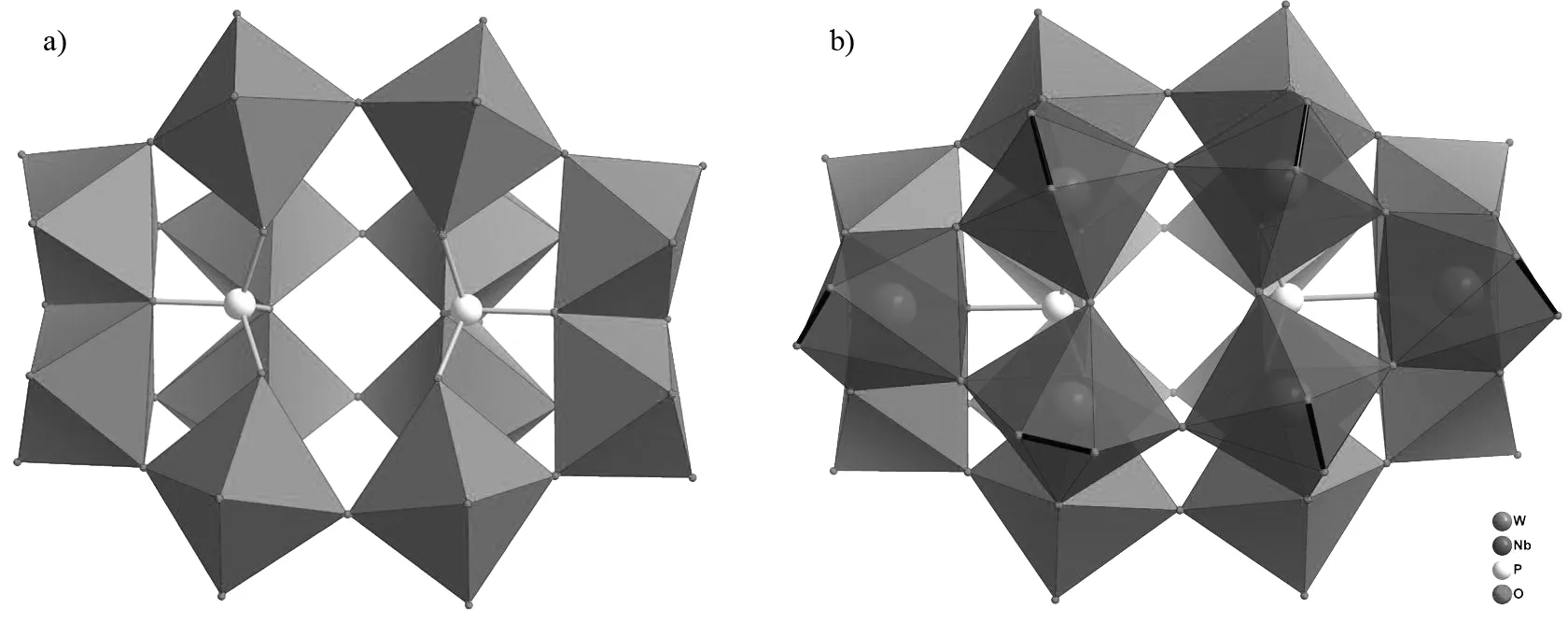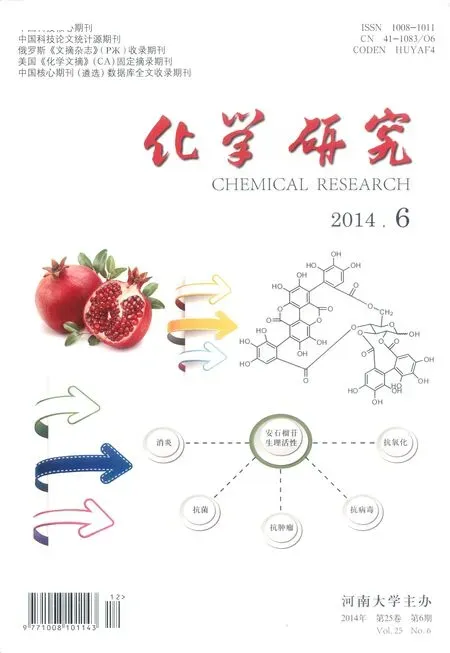Synthesis and photocatalytic activity of a W/Nb mixed-addendum polyoxometalate
LIANG Zhijie, LI Longsheng, HU Xiaojing, ZHANG Dongdi
(Key Laboratory of Polyoxometalate Chemistry of Henan Province, College of Chemistry and Chemical Engineering, Henan University, Kaifeng 475004, Henan, China)
SynthesisandphotocatalyticactivityofaW/Nbmixed-
addendumpolyoxometalate
LIANG Zhijie, LI Longsheng, HU Xiaojing, ZHANG Dongdi*
(KeyLaboratoryofPolyoxometalateChemistryofHenanProvince,CollegeofChemistryandChemicalEngineering,HenanUniversity,Kaifeng475004,Henan,China)
A W/Nb mixed-addendum polyoxometalate K3.5Na4[H4.5(NbO2)6P2W12O56]·12.5H2O (1) has been prepared under acid aqueous solution and in the presence of peroxide. X-ray structure analysis reveals that the polyanion of1is a hexa(peroxoniobium)-substituted P2W12derivative. Each of the six niobium atoms is coordinated by five oxygen atoms and one terminalη2-coordinated peroxo unit. Furthermore, the photocatalytic H2evolution activity of1has also been investigated.
mixed-addendum polyoxometalate;Wells-Dawson;niobium;photocatalysis
Polyoxometalates (POMs) are polynuclear clusters mainly constructed by Mo, W, V and Nb, with properties suitable for many potential applications ranging from catalysis, magnetism, to materials science[1]. These addenda metal atoms of POM cluster can be substituted with d-electron-containing transition metals, for instance, the substitution of niobium into polyoxotungstates is an interesting area of the field. However, the synthesis and characterization of niobium-substituted POMs remains relatively underexplored, particularly in comparison to the rich array of reported 1st row transition metal containing species[2]. To date, most known Nb/W mixed-addendum polyanions are based on Keggin-type structures[3-6]. Since 2005, our group has been interested in polyoxoniobates chemistry[7], as part of our ongoing investigation, herein, we present the synthesis and structure of a W/Nb mixed-addendum polyoxometalate, K3.5Na4[H4.5(NbO2)6P2W12O56]·12.5H2O (1). Moreover, the preliminary photocatalytic activity of compound1was also studied.
1 Experimental section
1.1 Materials and methods
All reagents were used as purchased without further purification. K7[HNb6O19]·13H2O[8]and K12[H2P2W12O48]·24H2O[9]were synthesized according to the published procedure, and the purity was confirmed by FT-IR spectra. IR spectra were recorded on an AVATAR360 FT-IR spectrophotometer using KBr pellets in the range of 4000-400 cm-1. Elemental analyses were obtained with a PerkinEimer Optima 2100 DV Inductively Coupled Plasma Optical Emission Spectrometry. Photocatalytic reactions were carried out in a Pyrex inner-irradiation-type reaction vessel with a magnetic stirrer at room temperature. The produced H2was analyzed by a GC9800 instrument.
1.2 Synthesis of 1
K7[HNb6O19]·13H2O (0.54 g, 0.39 mmol) was dissolved in a solution consisting of 4.5 mL of 30% aqueous H2O2and 55 mL of water with moderate stirring. Next, 4 mL 1 mol/L HClaqand K12[H2P2W12O48]·24H2O (1.6 g, 0.40 mmol) were added step by step. The pH was adjusted to ca. 2.0 by 0.5 mol/L HClaq. Stirring was continued for approximately 1 h and filtered. The resulting yellow filtrate was kept at room temperature to allow slow evaporation. Yellow plate-shaped crystals formed over a 1-month period. A rough yield: 0.62 g, 0.14 mmol (36% based on Nb). Elemental analysis for1, calculated(%): K 3.1, Na 2.1, P 1.4, Nb 12.8, W 50.4; Found(%): K 3.2, Na 2.1, P 1.4, Nb 12.9, W 50.8%.
1.3 X-ray crystallography
Suitable single crystals were selected and placed in a thin glass tube due to efflorescence. X-ray diffraction intensity data were recorded at 296(2) K on a Bruker Apex-II CCD diffractometer with Mo Kαmonochromated radiation (λ= 0.071073 nm). Structure solution and refinement were carried out with SHELXS-97 and SHELXL-97 program package[10]. Selected crystal data and structural refinements of compound1can be found in Table 1. CSD-428625(1) contains supplementary crystallographic data.

Table 1 Crystal data and structure refinements of compound 1
2 Results and discussion
2.1 Synthesis and structure
The hexalacunary anion [H2P2W12O48]12-is a metastable precursor that easily transforms in aqueous solution to other Wells-Dawson derivatives[11], however, after six NbVcentres are incorporated, the more stable polyanion [(NbO2)6P2W12O56]12-(1a) is formed. It is a hexa(peroxoniobium)-substituted P2W12derivative (Fig. 1). Each of the six niobium atoms is coordinated by five oxygen atoms and one terminalη2-coordinated peroxo ligand, whereas the twelve W atoms exhibit the conventional octahedral coordination. It must be mentioned that polyanion1aresembles structurally the {(NbO2)6P2W12O56} (1a’) cluster of HILL and coworkers[12]. Both polyanions derive from the classical Wells-Dawson {P2W18O62} core, with a contiguous longitudinal strip of six tungsten terminal oxo groups (W-Ot) replaced by six NbO2groups. However, in1a, the occupancy factor for each Nb is 1 instead of 5/6 in1a’. The average O-O bond length in the peroxo groups of1ais 0.136 nm, which is slightly shorter than that for1a’(0.143 nm). More importantly,1acan be crystallized without the need for cesium ions, which is different from the original report indicating an essential templating role of Cs+in the formation of Keggin-based analogues[3-5].

Fig.1 Representation of polyanion [P2W12O48]14- (a) and 1a (b)
2.2 IR spectroscopy
In the low-wavenumber region (σ< 1 100 cm-1), four characteristic bands at 1078, 947, 906 and 775 cm-1are observed, associated withνas(P-Oa),νas(W-Ot),νas(W-Ob) andνas(W-Oc). In comparison with the IR spectrum of the K6[α-P2W18O62]·14H2O (P2W18), the vibration peaks for1aare red-shifted by 14-25 cm-1, which may be ascribed to the stronger interactions between metal ions. In addition, the weak band at 870 cm-1originated from the antisymmetric stretching vibrations of peroxo groups is also observed. This is in good agreement with the results of the single-crystal XRD structural analysis.
2.3 Photocatalytic property
To demonstrate the potential use of polyoxoniobates in catalysis, the photocatalytic H2evolution activities of1was investigated. The total amount of H2evolved over 4 h was 2.9 mL (130 μmol), with a corresponding H2production rate of 325 μmol·h-1·g-1, which is smaller than that of P2W18(control, 553 μmol·h-1·g-1). This may be attributed to the peroxo moieties in its structure, which appears to decrease the catalytic activity.
3 Conclusions
In conclusion, six NbVcenters are incorporated into the tungstophosphate anion [P2W12O48]14-upon reaction with [Nb6O19]8-in aqueous solution and in the presence of peroxide. Interestingly,1can be finely crystallized without the use of Cs+. This is in contrast to the original report indicating an essential templating role of Cs+in the formation of1and Keggin-based analogues.
[1]LONG D L, TSUNASHIMA R, CRONIN L. Polyoxometalates: Building blocks for functional nanoscale systems [J]. Angew Chem Int Ed, 2010, 49: 1736-1758.
[2]OMS O, DOLBECQ A, MIALANE P. Diversity in structures and properties of 3d-incorporating polyoxotungstates [J]. Chem Soc Rev, 2012, 41: 7497-7536.
[3]HARRUP M K, KIN G S, ZENG H D, et al. Triniobium polytungstophosphates. Syntheses, structures, clarification of isomerism and reactivity in the presence of H2O2[J]. Inorg Chem, 1998, 37: 5550-5556.
[4]KIN G S, ZENG H, RHULE J T, et al. Synthesis, X-ray structure, and hydrolytic chemistry of the highly potent antiviral polyniobotungstate A-α-[Si2W18Nb6O77]8-[J]. Chem Commun, 1999: 1651-1652.
[5]LI S, LIU S, LI C, et al. Reactivity of polyoxoniobates in acidic solution: Controllable assembly and disassembly based on niobium-substituted germanotungstates [J]. Chem Eur J, 2010, 16: 13435-13442.
[6]RADKOV E, BEER R H. High yield synthesis of mixed-metal keggin polyoxoanions in non-aqueous solvents: Preparation of (n-Bu4N)4H3[PNbW11O40](M = V, Nb, Ta) [J]. Polyhedron, 1995, 14: 2139-2143.
[7]NIU J, MA P, NIU H, et al. Giant polyniobate clusters based on [Nb7O22]9-units derived from a Nb6O19precursor [J]. Chem Eur J, 2007, 13: 8739-8748.
[8]FILOWITZ M, HO R K C, KLEMPERER W G, et al. Oxygen-17 nuclear magnetic resonance spectroscopy of polyoxometalates. 1. Sensitivity and resolution [J]. Inorg Chem, 1979, 18: 93-103.
[9]CONTANT R. Potassium octadecatungstodiphosphates (V) and related lacunary compounds-potassiumα-dodecatungstodiphosphate [J]. Inorg Synth, 1990, 27: 104-109.
[10]SHELDRICK G M. SHELX 97, Program for crystal structure solution [CP]. Germany: University of Göttingen, 1997.
[11]ZHANG Z M, YAO S, WANG Y H, et al. New trimeric polyoxotungstate aggregates based on [P2W12O48]14-building blocks [J]. Chem Commun, 2008: 1650-1652.
[12]JUDD D A, CHEN Q, CAMPANA C F, et al. Synthesis, solution and solid state structures, and aqueous chemistry of an unstable polyperoxo polyoxometalate: [P2W12(NbO2)6O56]12-[J]. J Am Chem Soc, 1997, 119: 5461-5462.
[责任编辑:吴文鹏]
一例Wells-Dawson型铌钨混配多酸的合成及光催化性能
梁志结, 李龙升, 胡晓静, 张东娣*
(河南省多酸化学重点实验室,河南大学 化学化工学院,河南 开封 475004)
在双氧水存在条件下, 合成了一例Wells-Dawson型铌钨混配多酸 K3.5Na4[H4.5(NbO2)6P2W12O56]·12.5H2O (1), X射线单晶结构分析表明,化合物1的多阴离子是一个六过氧铌基团取代的P2W12衍生物. 六个铌原子分别与五个来自多酸框架上的氧原子和一个端位的过氧单元配位. 另外,对化合物1的光催化产氢性能进行了初步研究.
混配型多酸;Wells-Dawson;铌;光催化
date:2014-10-17.
Supported by the NSF from Henan Province (122300410126, 13A150058 and 142300410009).
Biography:LIANG Zhijie (1989-), female, master, majoring in polyoxoniobate chemistry.*
, E-mail:ddzhang@henu.edu.cn.
O 741DocumentcodeAArticleID1008-1011(2014)06-0570-03
10.14002/j.hxya.2014.06.004
——过氧碳酸钠

